Hickory Horned Devil
ID
ENTO-20NP (ENTO-540NP)
Introduction
Hickory horned devils (Fig. 1) are caterpillars of the regal moth or royal walnut moth, Citheronia regalis (Lepidoptera: Saturniidae). This native species can be found in much of the eastern half of the United States to Texas and the Midwest, but are more common in the south.
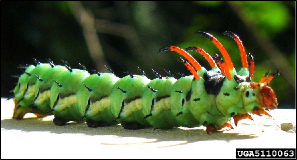
Description
Young hickory horned devil caterpillars may be orange or brown (Fig. 2), but the full-grown caterpillars are usually green with black and cream markings down the sides of their bodies (Fig. 1). Some mature hickory horned devils also have light blue markings (Fig. 3). Caterpillars close to pupation can even be a striking turquoise green. Occasionally, the caterpillars retain a tan or chocolate brown coloration but develop the black and cream markings seen in mature larvae.
Both young and older caterpillars possess pairs of large horns near the head and black spines down their backs. The horns and spines are more branched in the younger larvae (Fig. 2), and the horns near the head are reddish orange in older larvae (Figs. 1 & 3).
Mature hickory horned devil caterpillars are quite large and can grow up to 5.5 inches (14 cm) long.
Despite their size and ferocious appearance, these caterpillars are not dangerous or harmful. Their horns and spines are somewhat flexible to the touch, not very sharp, and are not poisonous.
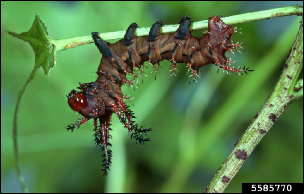
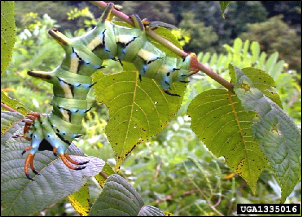
The attractive large adults are known as regal or royal walnut moths (Fig. 4). They have densely haired rusty-orange bodies with yellow bands. The forewings are grayish with rusty-orange stripes and large yellow spots. The hindwings are more orange than gray, with larger yellow markings. The wingspan usually measures between 3.75 to 6 inches (9.5 to 15.5 cm) across.
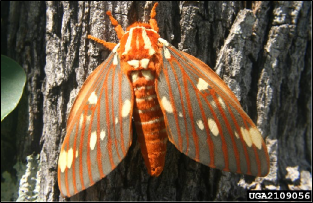
Life History
This insect has a complete life cycle of egg, larval, pupal, and adult stages. In late summer, mature caterpillars may wander before burrowing into the ground where they pupate over the winter. The following summer newly emerged adult moths climb out of the ground and crawl up nearby vegetation to expand their wings. Females emit pheromones to attract males, who may fly several miles in search of mates. Mated females lay eggs on host plants. Adults do not have functioning mouthparts and do not feed. They die about a week after emergence. There is one generation per year.
Common Host Plants
These caterpillars feed on various species of hickory and walnut, ash, sumac, sweetgum, sycamore, and persimmon.
Damage
Both the caterpillar and the adult moth are completely harmless. The hickory horned devil is not considered to be a plant pest and does not require any control measures.
Interesting Facts
This is the largest caterpillar found in North America, but the adult is not the largest moth. The largest adult moth in North America is the cecropia moth (Hyalophora cecropia), which also belongs to the lepidopteran Family Saturniidae.
The closely related pine devil caterpillar (Citheronia sepulcralis) resembles the hickory horned caterpillar in shape, but is smaller and less colorful (Fig. 5). Pine devil caterpillars are found in coniferous woodlands where they feed on several species of pine.
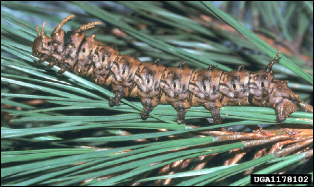
Revised
Theresa A. Dellinger, January 3, 2022.
Virginia Cooperative Extension materials are available for public use, reprint, or citation without further permission, provided the use includes credit to the author and to Virginia Cooperative Extension, Virginia Tech, and Virginia State University.
Virginia Cooperative Extension is a partnership of Virginia Tech, Virginia State University, the U.S. Department of Agriculture (USDA), and local governments, and is an equal opportunity employer. For the full non-discrimination statement, please visit ext.vt.edu/accessibility.
Publication Date
January 5, 2023



